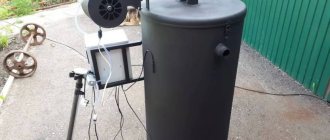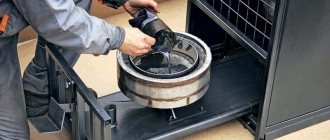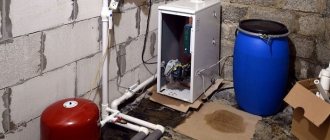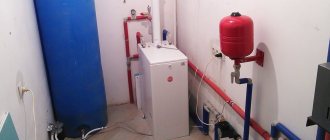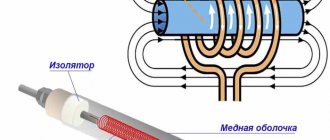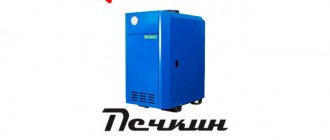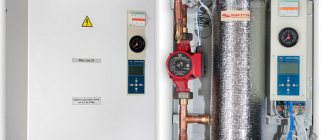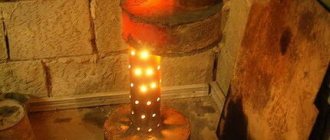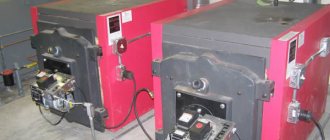How does a heating device work?
The design of the boiler is extremely simple. It includes two chamber compartments: evaporation and combustion. In the first, the process of preparing the oil for combustion occurs, in the second, it burns.
Everything happens as follows. From the waste reservoir, the pump supplies used oil to the evaporation chamber, which is located at the bottom of the device. Here, a temperature is maintained sufficient for the waste to heat up and begin to evaporate.
This is how a boiler with oil evaporation and forced air supply works (+)
Oil vapor rises to the upper part of the housing, where the combustion chamber is located. It is equipped with an air duct, which is a pipe with holes. Using a fan, air is supplied through the duct and mixed with oil vapor.
The oil-air mixture burns almost without a residue - the resulting heat warms up the heat exchanger, and the combustion products are sent to the chimney.
Preheating the oil is an essential part of the process. You need to understand that the waste contains a large amount of impurities and toxic substances. All this is broken down into simple carbohydrates, which are subsequently burned.
After which water vapor, carbon dioxide and nitrogen are formed - completely harmless elements. However, this result is only possible if certain temperature conditions are met.
Complete oxidation or combustion of hydrocarbons occurs only at a temperature of +600°C. If it is lower or higher by 150-200°C, then during the combustion process a large number of various toxic substances are formed. They are unsafe for humans, so the combustion temperature must be strictly observed.
General operating principle
If we want to get high-quality heating based on waste, we cannot simply take the oil and set it on fire, as it will smoke and stink. To avoid these unpleasant and hazardous side effects, you need to heat the fuel so that it begins to evaporate.
Volatile substances obtained as a result of heating will burn. This is the basic principle of operation of the heating unit during testing.
Application of perforated tube
To implement this principle, the design of the stove includes two chambers, which are connected to each other by a pipe with holes. Fuel enters the lower chamber through the filler hole, which is heated here. The resulting volatile substances rise up the pipe, becoming saturated with air oxygen through the perforation.
A schematic diagram of a two-chamber stove with a connecting perforated pipe allows you to understand exactly how a simple unit functions during mining
The resulting combustible mixture ignites in the chimney, and its complete combustion occurs in the upper afterburning chamber, separated from the chimney by a special partition. If the process technology is properly followed, virtually no soot or smoke is generated during combustion. But the heat will be enough to warm the room.
Using the plasma bowl
In order to achieve maximum efficiency of the process, you can go a more complicated route. Let us recall that our goal is to separate volatile components from the fuel by heating it. To do this, a metal bowl should be placed in the only chamber of the unit, which must not only be heated, but heated.
Through a special dispenser, waste will flow from the fuel tank into the chamber in a thin stream or drops. Once on the surface of the bowl, the liquid will instantly evaporate, and the resulting gas will burn.
The efficiency of this model is higher, since fuel supplied by drip burns better, and the problem of topping it up during the operation of the furnace disappears by itself
If everything is done correctly, the combustion of gases should be accompanied by a bluish-white flame. A similar flame can be observed when a plasma burns, which is why the red-hot bowl is often called a plasma bowl. And the technology itself is called drip feed: after all, fuel must be supplied in exclusively small doses.
With all the variety of designs, the operation of all heating units using waste fuel is based on the principle described above.
Boiler types
Waste oil boilers, depending on the scope of application, are conventionally divided into three types:
Heating
It is still recommended to install them not in residential premises, but in extensions to them. Although boilers are modern equipment, and manufacturers equip them with additional filters and guarantee the complete absence of extraneous “odors,” during operation this unit still emits the smell of machine oil.
Heating boilers inside are equipped with a heating unit with a water pipe and a pump, which can operate both from the electrical network and from the energy of the device itself. The pump circulates water in the system.
The operation of the boiler is based on the combustion of a mixture of waste oil vapors and air supplied by a fan, which is installed and operates on the compressor principle. The strength of the fire in heating units is regulated by a conventional hose with a tap valve.
The fan is the only moving part of the boiler, which may eventually fail - all other parts are stationary, and due to this, the boiler rarely needs repairs. Breakdowns are only possible due to poor maintenance or due to working with dirty oil.
Hot water
Floor type boiler
Designed for heating water and are actually full-fledged boilers. Their work is based on the platform principle - the boiler heats the plane on which the water tank is installed. A small pump located at the outlet of the tank regulates the pressure in the system. It is difficult to adjust the water heating temperature, and in the container it reaches 80-100°C. The standard capacity of a water heating device during production is 60-140 liters. It heats up in about 2 hours - most other types of 100 liter boilers heat water in about 4 hours.
This unit has two heating modes:
- Fast heating - for newly collected or cooled water.
- Maintain temperature - heating is switched to “wick” mode. In this state, a decent amount of fuel is consumed, and if the water tank is too small, then emissions of fumes are possible, the removal of which requires the construction of an additional chimney.
Hot water boilers for mining are most often installed in basements, and since they are not transportable, they must be installed as stationary equipment.
The use of electric hot water boilers for heating in winter 4–5 months requires costs in the region of 10,000 rubles, and the cost of heating with a hot water boiler using waste oil for the same period will be approximately 400 rubles. Such a noticeable difference makes exhaust water heating units an excellent cheap alternative to conventional boilers.
Schematic diagram of the operation of a waste oil burner KG/UB
They are multifunctional devices. Most often they are used to heat rooms that are not equipped with a water heating system. Such exhaust boilers are additionally equipped with a gas purification system, making the unit virtually smokeless. This version has very low fuel consumption compared to other waste oil devices.
The main advantage of such a unit is its mobility - it fits in the trunk of most cars. You can connect additional equipment to household boilers - a boiler, burner, heater and more. It will be indispensable outdoors, on a long trip, for traveling - it will be useful as a heater, a stove, a heating element, and more.
The only mandatory rule when working with such a device is to provide the fireproof area necessary for its installation or prepare a 30 cm depression in the ground.
Terms of use
In order for the boiler to serve for a long time without service, it is necessary to pay attention to the rules of use
Fuel
Used oil for boiler operation can be used for almost any purpose. The main thing is that it meets a number of requirements set by device manufacturers.
Photo 4. Draining used oil into a special container. The liquid itself is dark brown.
If you have additional filtration systems, feel free to use them. The cleaner the used oil is, the more efficient the combustion process will be. This also affects the fact that you will carry out less preventive maintenance during operation.
If analysis reveals that the fuel contains a large amount of water and antifreeze, then it is necessary to filter the fuel completely. There are special recommendations on how to remove such impurities.
Manufacturers most often recommend using hydraulic, motor, transmission oils, as well as oil from an automatic transmission. But it is not recommended to use fuel oil in the device.
The fuel for the boiler is calculated in accordance with the heat loss for each specific room. It is necessary to take into account data on the insulation of the place, its glazing, the operating mode of the boiler, as well as the required set temperature. Depending on the manufacturer, the calculation will be performed using individual formulas. It is better to contact the manufacturer directly to identify this issue.
The most commonly used formula is:
B = d*(h1-h2) + d*(h1+h2) /qn
Where: h1 - efficiency factor,
h2 is the enthalpy of the fuel,
d is the heat of combustion of fuel,
qn is the temperature and specific heat of the oil.
How to properly and safely pour fuel into the boiler?
Before starting work, you need to carry out a number of actions that will ensure the safety of using the device:
- Open the container with the liquid. This is necessary so that it has time to interact with oxygen.
- After this, disconnect the device from the network and power, check the degree of sealing of the seams.
- Fill the collection pan with oil. You need to pour a 10mm layer. The oil must be clean.
- Add 100 ml of kerosene to this liquid.
- Take the wick and wet it in the ignition.
- Lower to the bottom of the container.
- Set fire to the waste.
- Watch how the seams and oil behave. All actions must be carried out with gloves.
- Close the lid.
- After this, the device will start working, and you can check how efficiently it functions.
Photo 5. Filling a homemade boiler with waste oil. Fuel is poured into the lower part of the unit.
Do not get oil on foreign parts or parts of the device. During operation, all additional sources of oxygen supply, such as doors or windows, must be closed.
Advantages and disadvantages
Since oil heating devices themselves are inexpensive and use cheap fuel, they pay for themselves quickly. Self-assembly is even more profitable (of course, with strict consideration of all technological requirements and proper operation, but this will be discussed in the following sections). With proper assembly and proper adjustment, the oil burns completely and does not form toxic products. Oil boilers contain a very small number of parts, which not only simplifies assembly, but also reduces the likelihood of breakdown
What is important is that the heating rate of both the equipment itself and the room where it is installed is very high
But it is worth considering possible problems. Thus, oil boilers quickly burn out oxygen. Therefore, you will have to make a lot of effort to create good ventilation. The use of used oil leads to frequent clogging of boilers; they will have to be serviced and simply cleaned more often than other samples. Boilers of this kind allow the use of not only individual types of natural or synthetic oil, but also a combination of them.
But the use of a variety of raw materials causes a high risk of the presence of specific impurities. Therefore, you will have to supply the section that supplies fuel inside the boiler with a special filter. Due to the rapid clogging of the cleaning system, it needs to be replaced regularly. Thus, the obvious weaknesses and strengths of an oil boiler are determined precisely by the specifics of the fuel used. You can characterize the system more accurately if you understand the features of its design.
Installation
A key requirement when installing waste oil boilers is compliance with fire safety standards. It is prohibited to use them without an equipped chimney. To protect ceilings from overheating, special covers are used. It is necessary to provide a special damper, with which you can block the draft and avoid excessive penetration of cold in the event of a boiler shutdown. Both factory-made and home-made structures consume oxygen abundantly, so care should be taken to ventilate the boiler room.
It is recommended to install boilers on a stone base or on top of heat-resistant tiles. Sheathing with wooden and plastic elements is prohibited; only painting with heat-resistant paints and varnishes is permissible. Since used oil will have to be continuously refilled, it is worth preparing access routes to the boiler in advance. Considering the high heating of the equipment, it is not advisable to place it where there are easily flammable or damaged items. Of course, the heating device should not create any obstacles to the movement of people.
Sometimes a concrete platform is created under the boiler, which is equipped with a shallow side. This is a passive safety element in case of a fuel spill. The concrete mass must be poured strictly according to the level to eliminate mistakes. The best location for the automatic control unit is on the wall. But you cannot place it on top of the lid of the boiler itself, otherwise the microcircuits will overheat and fail.
Hoses through which oil is pumped, as well as electrical wires, must be removed from the surface of the boilers. What will happen even if they touch briefly is not difficult to guess. The thermal sensor is installed inside the tube located on the side of the boiler. The reservoir into which used oil is poured is placed no closer than 70 and no further than 150 cm from the heater. The oil pump adapts to the neck of the barrels used.
The diameters of the chimneys are selected equal to the outlet from the boiler, although sometimes they can be larger. You should not make chimneys higher than 5 m, this almost inevitably causes instability during combustion. It will not be possible to provide full fuel combustion power. It is recommended to nail down a steel sheet before firing. A box of sand in the room where the boiler is placed will also not hurt.
The minimum diameter of the chimney is 11 cm, narrowing is not allowed. It is recommended to make horizontal fragments only when it is impossible to do otherwise. When a smoke duct is passed through a wall, it must be pierced at a strictly 45 degree angle. The remaining fire and explosion safety requirements are the same as for a coal or wood stove. If you can reduce the number of welds, you should do so.
Types of structures under development
Depending on the area of application, boilers using waste oil as fuel can be divided into three groups:
- household stoves;
- water heating units;
- heating boilers.
Household stoves are installed in rooms that, for a number of reasons, cannot be equipped with water heating. These units are characterized by reduced fuel consumption, and their design ensures the most complete combustion of oil. Household equipment is virtually smoke-free. In addition, furnaces are often equipped with emission treatment systems, which increases the safety of their operation. The main advantage of units of this type is their mobility. Small dimensions make it easy to transport the stove and install it in a small room
It is also important that the device, if necessary, can be easily retrofitted with a water circuit or a cooking platform
Household oil stove
Water heating units at the module level for afterburning gases have a special platform on which a container of water rests. Its toroidal shape gives an additional advantage, since heating is carried out both from below and from the side of the smoke channel, which runs inside the tank. For autonomous water supply, a small water pump is installed at the inlet of the boiler. Due to the high temperature, water can be heated much faster than in factory water heaters. For example, a 100 liter tank will reach a temperature of 20°C to 65°C in about two hours, while an electric or gas appliance will take twice as long. If we talk about the cost of a standard liter of hot water, then when using waste water, costs are reduced by 20–25 times.
A container installed at the level of the afterburning zone turns the exhaust furnace into a powerful water heater
Heating boilers are used to connect to water heating systems, therefore they are equipped with exhaust gas afterburning devices, filters and safety devices. Despite all precautions, it is recommended to install waste oil heating equipment in separate rooms or outbuildings. Heating of water in heating units is provided by a heat exchanger installed in the fuel combustion zone
It can be made either with a continuous water jacket or in the form of a spiral tubular circuit. The movement of the thermal agent in the system is possible thanks to a circulation pump powered by electricity. The coolant temperature is adjusted by decreasing the flame temperature. For this purpose, the boiler is equipped with a forced air supply system. By decreasing or increasing the turbine speed, the air supply to the combustion zone is regulated. Installing a thermostat allows you to automate this process
Heating of water in heating units is provided by a heat exchanger installed in the fuel combustion zone. It can be made either with a continuous water jacket or in the form of a spiral tubular circuit. The movement of the thermal agent in the system is possible thanks to a circulation pump powered by electricity. The coolant temperature is adjusted by decreasing the flame temperature. For this purpose, the boiler is equipped with a forced air supply system. By decreasing or increasing the turbine speed, the air supply to the combustion zone is regulated. Installing a thermostat allows you to automate this process.
A boiler with a spiral-type water circuit will ensure the operation of the heating system of a country house
Diesel heating
This heating method is used to heat suburban properties and garages.
What does it represent?
This heating has a similar principle of operation with a water circuit, but it also has its own nuances. The boiler that heats the coolant runs on diesel fuel.
The liquid is distributed throughout the system and returned back using a circulation pump. After heating the coolant, the source stops working, and after cooling it resumes.
Advantages and disadvantages
Advantages of diesel heating:
- automated boiler operation;
- independence from central heating, due to which the user turns the heating on and off at his own discretion, based on the outside temperature;
- the prevalence of fuel that can be purchased at any gas station.
Flaws:
- high cost of diesel fuel;
- high price of equipment and components.
Review of Russian-made boilers using waste oil
Domestic waste oil boilers are manufactured mainly in Voronezh, where the manufacturer has all the necessary documents related to the production of products. There are also other small businesses. However, most of them do not have a state certificate for the manufacture of heating equipment
You should pay attention to this when purchasing a boiler
Powerful boiler STV1 is characterized by high efficiency
The Teploterm GMB 30-50 kW double-circuit waste oil boiler is characterized by high quality workmanship in every detail. Thanks to a multifunctional microprocessor, it is equipped with an automatic control system. The device has many options that simplify the operation of the device, making it safe. Fuel consumption – 3-5.5 l/hour. The cost of the model is 95 thousand rubles.
A popular model is the Gecko 50 pyrolysis boiler. The device can operate not only on waste oil, but also on crude oil, diesel fuel, fuel oil of all brands, kerosene, fats and various types of oil. The boiler is undemanding to the quality and viscosity of the fuel. There is no need for pre-filtration and heating.
The design has small dimensions (46x66x95 cm) and weight 160 kg. The device is characterized by high efficiency, reliability of all elements and connecting units, ease of maintenance and repair. The maximum temperature in the device reaches 95 °C. The fuel consumption is 2-5 l/hour. Power consumption is 100 W. The price of a heating boiler using waste oil is 108 thousand rubles.
The KChM 5K combination boiler has a cast iron reliable body
The Stavfurnace boiler STV1 is characterized by high efficiency. The power of the device is 50 kW. The fuel mixture consumption is 1.5-4.5 l/hour. The body dimensions are 60x100x50 cm. The device is equipped with a reliable modulating burner for a waste oil boiler, which has a high emission rate. The device is equipped with a fuel filter, pump and water tank. Various types of oil, diesel fuel and kerosene can be used as fuel. The price of the boiler is 100 thousand rubles.
The combined apparatus KChM 5K has a cast iron body. It can operate not only on mining, but also on gas and solid fuel. The power of the device is 96 kW. The model is distinguished by high quality parts, safety in operation and durability. You can buy a boiler for 180 thousand rubles.
Expensive domestically produced waste oil boilers
The domestic automatic waste oil boiler Teplamos NT-100 is characterized by an expanded configuration. A double-circuit boiler can be used not only for heating, but also to provide hot water supply in the house. The model is characterized by high quality manufacturing of all components. External parts are powder coated to protect them from corrosion. The body has an internal thermal insulation coating in the form of high-density glass wool.
The Ecoboil-30/36 exhaust boiler can be used to heat a room up to 300 square meters. m
For ease of control, the device is equipped with a remote control, which allows it to operate in automatic mode. It consists of a switch, thermostat, thermohygrometer and emergency thermostat.
The boiler has dimensions 114x75x118 cm and weight 257 kg. The maximum power consumption reaches 99 kW. Fuel consumption ranges from 5-6 l/hour. The price of a waste oil boiler is 268 thousand rubles.
A single-circuit heating device using Ecoboil-30/36 can be used to heat a room of up to 300 square meters. m. It has dimensions of 58x60x110 cm. The power of the device is 28 kW. Fuel consumption can vary from 0.9 to 1.6 l/hour. The boiler operates on any type of oil, regardless of its quality. You can also use kerosene and alcohol for it. The cost of the boiler is 460 thousand rubles.
The Belamos NT 325 water-heating fire-tube boiler, with a power of 150 kW, is capable of heating a room of more than 500 square meters. m. Fuel consumption reaches 1.8-3.3 l/hour. Thanks to the presence of a heat exchanger, it has high efficiency. Equipped with a control unit with a smooth adjustment function and the ability to maintain the set coolant temperature. It can operate on any type of liquid fuel that does not require filtration or heating. The price of the boiler is 500 thousand rubles.
The Teplamos NT 100 double-circuit boiler can be used not only for heating, but also to provide hot water supply in the house
Rating of popular models
The long service life of a boiler and its efficiency largely depend on its quality. Today, several heating devices operating on liquid fuel are recognized as the best models.
Russian-made waste oil boilers:
- "GEKKON 50";
- "EcoBoil-18/30";
- "KChM-5-K-38";
- "Teplamos NT - 100".
European models:
- "DanVex B30";
- "EnergyLogic EL-375B";
- "Euronord K200";
- "Ecoheat 60S".
Waste oil boiler DanVex B30
All heating units operate on various types of waste oil and its mixtures. Their feature is ease of use and high performance coefficient.
Compliance with safety precautions when operating homemade stoves
Before connecting the boiler, you should consider not only the installation method and placement points for additional devices and shut-off and control valves, but also the method of venting the chimney to the outside. If it passes through a ceiling built using flammable materials, then a metal pencil case with twice the diameter is installed in it. The free space between the pipes is filled with asbestos or other non-flammable material with good thermal insulation properties.
For these purposes, a centrifugal pump and a membrane-type expansion tank are installed on the return line just before the entrance to the boiler. It is necessary to ensure that the system does not depressurize when temperature and pressure increase. A pressure line is connected to the upper branch pipe, and to regulate the temperature of consumers, a thermostatic head or other control device (three-way valve, valve to reduce the cross-section of the supply pipe, etc.) is installed in front of each radiator. To remove air plugs, an air vent is installed at the top of the system.
Piping diagram for a boiler running on waste oil
The piping of a unit operating in mining requires taking into account the inertia of this type of equipment. In other words, the change in coolant temperature occurs gradually, so the unit must be equipped with a safety valve. It will allow you to relieve pressure when it rises to a critical level.
When they want to insure themselves in case of a shortage of used oil, an electric boiler is installed next to the homemade boiler. You can connect an additional unit in two ways - in series or in parallel. The advantage of the first method is that the coolant heated using a flame bowl will flow into an electric boiler, which can be set to a certain response temperature.
Parallel activation implies independent operation of two heating units and is characterized by the absence of these disadvantages. Unfortunately, this method is not without its drawbacks, one of which is the need to install a hydraulic switch and accurately coordinate the operating mode and supply of the return line.
The quality of automobile waste, as a rule, leaves much to be desired. When using them, carbon deposits may form, which will have to be cleaned off from time to time.
You can see how hot a boiler can get that uses waste oil as fuel: you can’t dry socks near it, put a kettle of water or lay out dry boards
In addition, the following safety precautions should be observed.
- The diameter of the chimney should not be less than 10 cm. A sandwich chimney is preferable: less soot is deposited on its surface.
- There cannot be any flammable substances near the boiler, including the fuel tank. Only at a safe distance.
- Avoid getting water or other liquid into the chamber with hot oil. The consequences of such a leak are presented in the video in the final part of this article.
- During the operation of a boiler using waste oil, heating temperatures significantly exceed those achieved during the combustion of solid fuel. Therefore, thick-walled materials are chosen for this design.
- It is advisable to equip the boiler room with a forced air circulation system.
Precautionary measures
The main question of interest to consumers is how safe heating is. Complaints about an unpleasant odor from burning oil indicate non-compliance with the operating rules of the heating device.
It is important to make the right choice of mining. It should not contain substances that can easily ignite, such as gasoline or acetone, and there should also be no third-party additives. They are the ones who contaminate the burner section
When heating, the following safety precautions must be observed:
They are the ones who contaminate the burner section. When heating, the following safety precautions must be observed:
- The cross-section of the pipe must be at least 10 cm. The best option would be to use a sandwich chimney. A small amount of soot forms on its surface.
- Fuel containers should not be stored near the device.
- Containers with oil must be hermetically sealed. If water gets into the fuel, splashing will occur during burner operation, which increases the risk of fire.
- The temperature impact on a boiler with waste oil is much greater than on devices with solid fuel. Therefore, it is necessary to observe the thickness of the walls of the heat exchanger and combustion chamber (2 mm).
To avoid smoke and gas contamination in the boiler room, it is necessary to have a forced air circulation system. It is recommended to maintain air exchange with the following parameters: 180 cubic meters per hour per 1 sq. m. Only if these requirements for heating a country house are met, safe operation of the heating system is possible.
Self-made heating is quite economical and worthy of competing with other types of heating. Its specificity lies precisely in the used oil. This system is good if there are no other options or there is a sufficient supply of fuel. The main area of application for such structures is industrial enterprises where there is a large amount of waste oil.
Principle of operation
Boilers using selected oil are characterized by a fairly simple operating process. The heating device operates as follows:
- Used oil is supplied from the fuel tank to the evaporation compartment using a pump. In this chamber, due to the high temperature conditions, preparation for the combustion process is carried out.
- Heating to the temperature required for evaporation, the waste in the form of oily steam rises to the upper compartment - into the combustion chamber. This part of the boiler has a pipe with holes for supplying air via a fan. Thanks to this, air masses, penetrating into the chamber, combine with oily vapors, promoting complete combustion of the fuel.
- The heat released during the process heats the heat exchanger, while all combustion products exit through the chimney.
A fuel heating chamber is a mandatory device in exhaust boilers. This oil contains a considerable amount of various toxic impurities, which, when heated, break down into simple carbohydrates. After combustion, harmless substances are formed - nitrogen, water vapor and carbon dioxide.
How to make a waste oil boiler with your own hands
The simplicity of the design of such heating devices allows you to make them yourself. In this case, it is necessary to have metalworking and welding skills.
Tools and materials
To make a boiler with your own hands, you need the following equipment:
- Bulgarian;
- welding machine;
- hammer.
To make a waste oil boiler with your own hands, don’t forget the grinder.
As a material for the heating structure, you need to purchase:
- fire-resistant asbestos sheet;
- heat-resistant sealant;
- steel sheet 4 mm thick;
- metal pipe with a cross section of 20 and 50 centimeters;
- compressor;
- ventilation pipe;
- sweeps;
- bolts;
- steel adapters;
- half-inch corners;
- tees;
- reinforcement with a cross section of 8 millimeters;
- pump;
- expansion tank.
The boiler body for heating small rooms can be made of pipe; for a device with a higher power it is best to use steel sheets.
Manufacturing process
The waste oil unit can be built in any shape. To heat a garage or small agricultural buildings, it is best to make a small boiler from pipes.
The manufacture of such a heating device consists of the following steps:
- A metal pipe with a large cross-section is cut so that its size corresponds to one meter. Two circles corresponding to a diameter of 50 centimeters are prepared from steel.
- The second pipe with a smaller diameter is shortened to 20 centimeters.
- A hole corresponding to the size of the chimney is cut out in the prepared round plate, which will serve as a cover.
- In the second metal circle, intended for the bottom of the structure, an opening is made, to which the end of a pipe of smaller diameter is connected by welding.
- We cut out a cover for a pipe with a cross-section of 20 centimeters. All prepared circles are welded as intended.
- Legs are constructed from reinforcement and attached to the bottom of the housing.
- Small holes are drilled in the pipe for ventilation. A small container is installed below.
- An opening for the door is cut out in the lower part of the body using a grinder.
- The chimney is attached to the top of the structure.
To operate such a simple boiler during mining, you just need to pour oil into the tank from below and set it on fire with a wick. Before this, the new structure should be checked for tightness and integrity of all seams.
Construction of a more powerful boiler
Two boxes are made from durable steel sheets, which are connected using a perforated pipe. In the design it is used as an air outlet.
The subsequent manufacturing process of the heating device has some features:
- A hole is made in the lower body of the boiler to supply oil to the evaporation tank. A damper is attached opposite this container.
- The box located in the upper part is complemented by a special hole for the chimney pipe.
- The design is equipped with an air compressor, an oil supply pump and a container into which fuel is poured.
DIY waste oil boiler
If water heating is required, an additional circuit is connected, which requires the installation of a burner. You can build it yourself:
- half-inch corners are connected by bends and tees;
- a fitting is attached to the oil line using adapters;
- all connections are pre-treated with sealant;
- a burner cover is cut out of sheet steel to match the sockets on the manufactured boiler;
- two different sized steel plates are used to install the burner;
- the inside of the tube adapter is tightly covered with an asbestos sheet, which is secured with sealant and secured with wire;
- the burner is inserted into the housing intended for it;
- after this, a smaller plate is fixed in the socket and covered with four layers of asbestos;
- a large plate is mounted as a mounting plate;
- holes are drilled in it for fastenings, and an asbestos sheet is applied on top;
- two prepared plates are connected using bolts.
To prevent the burner from falling apart while the boiler is operating, all parts should be carefully and tightly secured. The device is ignited by a glow plug.
Waste oil boilers are considered economical and practical devices. You can purchase them at a specialty store or build them yourself. When using such heating devices, you must remember the safety rules, which include the mandatory installation of a chimney, the presence of a ventilation system and proper storage of liquid fuel.
Organization of drip oil supply
To do this, perform the following actions:
- Cut a piece 30-40 cm long from a pipe with a diameter of 8 cm.
- Make two holes in the pipe: one 2 cm from the bottom, the other 4 cm from the top. The diameter of the holes is 1 cm.
- Fittings are welded to the holes.
- A circle with a hole in the center is welded to the lower end of the pipe. Hole diameter - 1 cm.
- A fitting is welded to this hole.
- Similar actions are done at the other end. However, the hole should have a diameter of 3-4 cm and instead of a fitting, a nut with the appropriate dimensions is welded. You need to screw a long bolt into this nut, which will serve as an adjustment rod. You need to make several small holes in the plug for air movement.
- Flexible hoses are attached to the fittings. Two side flexible tubes are lowered into a container with oil. Before this, a pump is placed at the end of the hose attached to the lower side fitting, and another piece of tube with an oil filter is attached at the end.
- A drip clamp or some equivalent is placed on a short hose connected to the fitting at the lower end of the pipe. This element will allow you to control the supply of used oil.
- The structure with hoses is suspended in a vertical position.
- A funnel is placed under the end of the hose with a clamp, from which a flexible tube extends. It is connected to a pipe that is located inside the air duct.
After this, the homemade boiler for heating the house is ready. It is worth saying that its use is not easy, because after each oil change you need to adjust the fuel supply, or rather the drop frequency.
If the water jacket does not have time to absorb all the heat, then you can build a special chimney shown in various videos with an additional heat exchanger.
